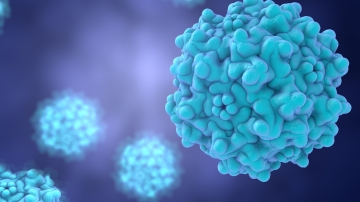Aliquotation & homogenization of viral vectors
Table of contents
ShowIn the manufacturing of viral vectors aseptic aliquotation is a critical process step. It is the practice of dividing one larger container of vectors into smaller samples. It is important to generate the same amount of smaller aliquots whilst maintaining the consistency of the mixture.
In this article, we uncover the significance of a professional aliquotation process, the challenges entailed in filling AAV vectors, and the innovative solutions supporting to master those challenges.
Importance of aliquotation of viral vectors
The precise aliquotation of viral vectors carries importance in several key aspects:
- Sample Size Precision
- Process Consistency
- Safety and Contamination Control
- Splitting into small batches minimizes Freeze-Thaw Cycles
- Maintaining Product Viability
Determining the initial sample size is a decision that affects the entire process. Accurate aliquoting ensures that researchers, operators or process engineers in viral vector manufacturing have precisely the amount of viral vectors needed for their further process.
This not only minimizes waste and ensures that the samples are statistically representative, there are further benefits of accurate aseptic filling. It guarantees that each sample accurately reflects the entire viral vector solution, reducing the potential for variation in experimental results.
Working with small aliquots enhances safety by minimizing the risk of contamination. It protects the purity and integrity of the viral vector solution. And is therefore a relief for researchers and operators. Additionally, aliquoting helps minimize freeze-thaw cycles, since the use of small batches means that the entire substance does not have to be thawed and refrozen. The single batch that is needed is used at a time, which ensures efficient use. Frequent freeze-thaw cycles can adversely affect the stability and potency of viral vectors. Aliquoting allows maintaining vector viability for longer periods of time, resulting in more reliable results.
Challenges in filling AAVs or other vectors
AAV vector solutions often exhibit high viscosity, making them difficult to manage during the filling process. The viscosity can lead to uneven aliquotation and homogenization, affecting the quality of the samples.
Maintaining stringent aseptic conditions is paramount in gene therapy, so in handling with viral vectors like adeno-associated virus (AAV) vectors. Conventional manual filling processes can introduce contaminants, posing a risk to the vector's quality. Therefore, an automated aseptic aliquotation process in a fully closed system is crucial.
As the demand for AAV vectors continues to rise, the need for efficient and scalable filling solutions becomes increasingly pressing. Solutions that can accommodate various volumes and optimize production efficiency are essential. 1
Aseptic filling of viral vectors
To address the challenges in filling viral vectors, Single Use Support offers innovative solutions. The fill platform employs closed and automated filling systems based on single-use technology. This approach ensures aseptic, cGMP-compliant filling processes into single-use bags, reducing the risk of contamination. Fill systems from us are already being used worldwide to fill viral vectors.
Our filling systems for small volumes are ideally designed for the specific requirements in the early stage research and development as well as for commercial serial production of AAVs or other viral vectors. The modular platforms enable scalable processes, accommodating volumes ranging from 1mL to 1000mL and scaling up to 128 single-use bags per run. This versatility proves invaluable for laboratories, clinical trials, and production in advanced therapies.
Homogeneous filling of viral vectors
Achieving homogeneity in viral vector aliquots is crucial. Single Use Support’s cutting-edge solution for kneading and cooling prior to filling addresses this challenge. The goal is a homogeneous distribution of the substances into the individual bioprocess containers, reducing aliquot-to-aliquot deviations. This is particularly important for liquids that are viscous and cannot be filled homogeneously into individual batches without external intervention.
RoSS.PADL is a scalable platform designed to gently knead single-use bags, ensuring a homogeneous mixture of the viral vector solution. This automation eliminates the need for human intervention, making the process reproducible and standardized. As a result, patient safety is greatly improved as it reduces aliquot-to-aliquot deviations in cell count, concentration level and active ingredient during aliquoting into smaller single-use bags or medical devices. The consistency in each filled bag results in more accurate and reproducible dosing of drug efficacy for the patient.
The optional cooling mechanism guarantees that the viral vectors maintain the correct temperature throughout the process, preserving its integrity. Cell suspension, for example, needs to be homogenized during aliquotation, which is why it is vital to limit the process time for temperature control, homogenization and aseptic filling & freezing in order to prevent cellular degradation.
Conclusion: Considerations in filling AAVs or other viral vectors
In conclusion, the precise aliquotation and homogenization of AAV vectors are essential elements in bioprocessing. Our innovative systems offer effective solutions to tackle the challenges associated with filling and homogenizing viral vectors. Moreover, our comprehensive end-to-end processes provide further solutions for the downstream processing of viral vectors.
Using our single-use assemblies, filling takes place in a closed system and completely automatically. Once the substances are filled into the single-use bag, protected in the RoSS shell, they are ready for further transport or safe storage in a frozen state. Plate freezing with our freeze-thaw platform allows controlled freezing of the AAV vectors all the way down to temperatures as low as -80°C. This capability ensures the safe and secure storage and transportation of these valuable substances over extended periods.
By leveraging the right tools and technologies, we can guarantee the safe and efficient delivery of gene therapies, propelling the field of medicine towards groundbreaking advancements.
- Manufacturing Challenges and Rational Formulation Development for AAV Viral Vectors, https://www.sciencedirect.com/science/article/pii/S0022354921001933, Published July 2021











